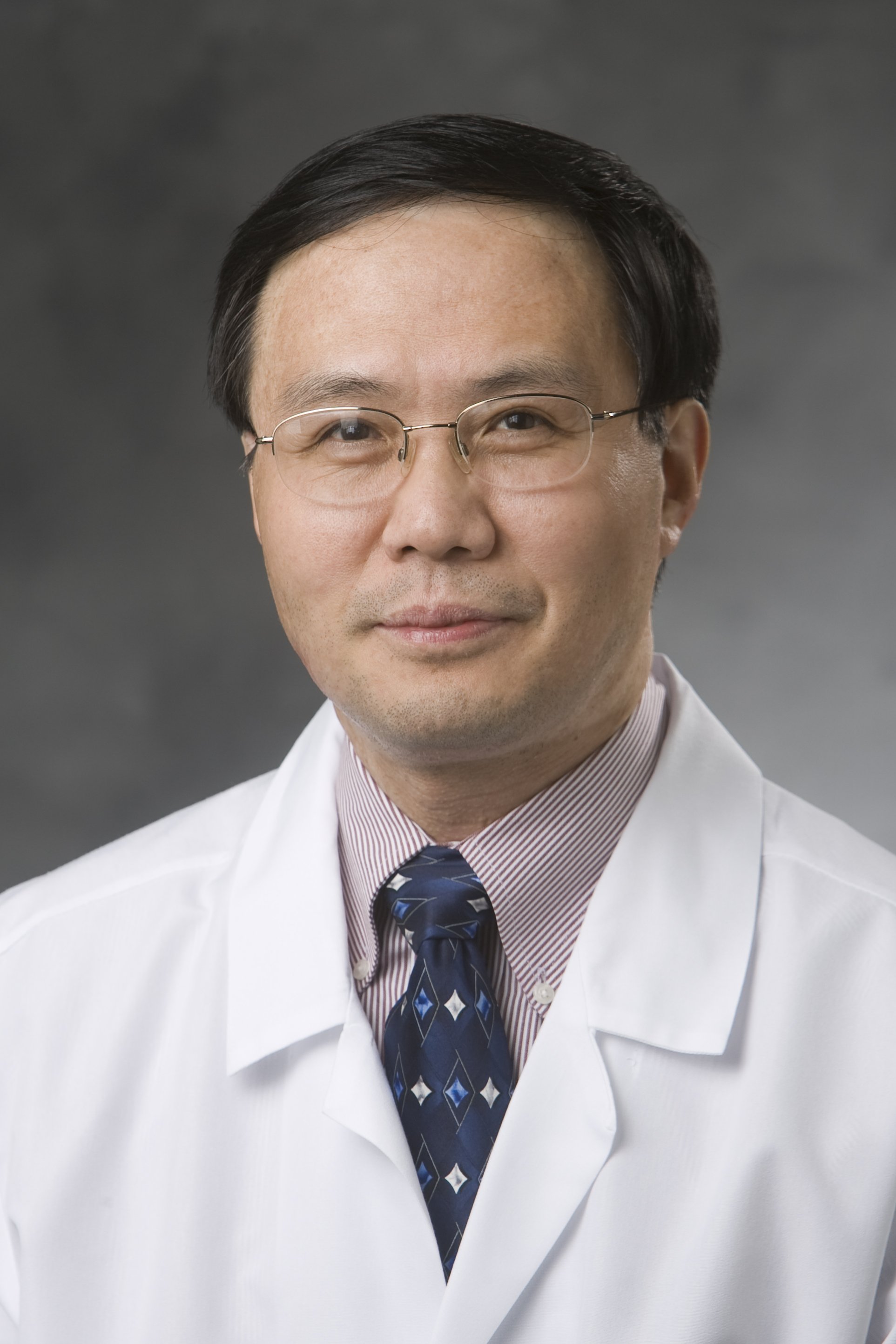Exclusive Interview with
Dr. Yong-Hui Jiang
JUNE 2024
We wanted to share with you a recent interview with Dr. Yong-Hui Jiang, one of the scientists we’re working with at Yale School of Medicine to identify molecular therapies for PURA Syndrome. Dr. Jiang and his team will be using the mice developed at The Jackson Laboratory to study the molecular, cellular, and behavioral phenotypes in mice. This testing will help deepen our understanding of PURA Syndrome and can be used to develop treatments for PURA Syndrome in the future.
This interview has been edited and condensed for clarity.
Jack’s Tomorrow: How did you first get involved in the study of rare diseases?
Dr. Yong-Hui Jiang: My clinical speciality is clinical genetics, so naturally I see rare diseases in patients. My research, of course, started with Angelman when I was a graduate student at Baylor College of Medicine, working with my mentor, who is also a physician-scientist and a clinical geneticist. So to me, I stepped into rare diseases quite naturally, it’s all sort of associated with my training.
Jack’s Tomorrow: How/when did you first hear of PURA Syndrome?
Dr. Jiang: Of course, I pay attention to all the literature and publications, and I [knew about] PURA Syndrome almost immediately after it was first discovered. Then I started to get into more detail last year. I have my own [PURA Syndrome] patient here at Yale, the first patient I’ve encountered. [Jack’s Tomorrow] contacted me around the same time, so I got a lot more details looking into PURA Syndrome.
Jack’s Tomorrow: What is appealing to you about working on finding a cure for PURA Syndrome?
Dr. Jiang: My research is dedicated to understanding [how] many, many genetic syndromes like PURA affect the brain function, so any syndrome that affects the brain is always appealing to me. The reason I’m interested in brain development, and for sure as a physician, I’m interested in how to help the families with PURA and many other similar syndromes.
Jack’s Tomorrow: How can your work on Angelman Syndrome, for example, lead to progress on a different disorder such as PURA Syndrome? Are there learnings from one neurodevelopmental disorder that could be applied to another?
Dr. Jiang: My experience understanding or developing a treatment for Angelman started 25 years ago. I contributed to the discovery of the Angelman gene, and that created the first animal mouse model for Angelman which was used to develop the first molecular treatment two years ago. We are continuing to work on advancing CRISPR editing for Angelman syndrome. So clearly, everything we learned from Angelman is applicable to PURA Syndrome, particularly for the technology. Of course, PURA and the Angelman gene [perform] different functions, but for technology such as how you deliver the gene therapy or gene editing, how you assess PURA Syndrome or Angelman Syndrome in a clinical trial, there’s significant overlap in Angelman and PURA. So I’m pretty confident that everything we learned from Angelman will benefit PURA Syndrome in the long-term.
Jack’s Tomorrow: How do you view the role of Jack’s Tomorrow and other nonprofit organizations in advancing rare disease research?
Dr. Jiang: I’m impressed by Jack’s Tomorrow. I [met] Jean and her husband two years ago when she attended the Angelman annual conference [FAST’s Global Science Summit]. That’s the first time she shared with me about the foundation [Jack’s Tomorrow]. Before that, we were mutually introduced by my other colleague from FAST, Dr. Allyson Berent. She introduced Jean to me because of my connection to rare diseases. So far, I think that’s the way to promote the research – create a foundation and organize the families, supporting the initial research or seeding the research, and to generate preliminary data that eventually can lead into larger funding from the federal government. So I’m impressed so far by the foundation’s efforts and investment and the resources the foundation provides. In particular I’m also very impressed by Jean and her husband. They've been very engaged in this process and they are very knowledgeable just a few years after their son Jack’s diagnosis. To me, that’s a productive way to move forward. As you know, working in a rare disease like PURA, there’s a lot of challenges. For the resources, to gather investigative interest – it requires many, many different people [to be] involved. Parent advocacy groups are critical to push research forward.
Jack’s Tomorrow: An important part of your work has been the discovery of two novel long transcripts of MALINC1. Can you talk a little bit about the significance of MALINC1, and how this discovery might lead the way towards a potential treatment?
Dr. Jiang: I’m trained as a molecular geneticist first, so every time I pick a new disease or a new gene, my first approach is to understand fully the gene structure, how the gene is regulated. That’s the reason we stepped in to understand MALINC, which is very close by, and we wanted to understand the PURA structure. To me, it’s always critical to fully understand the molecular genetic nature of the gene involved with PURA first, before you step into understanding the functional aspects and then develop a treatment. So MALINC is still ongoing, the understanding is complex, but we hope we have better knowledge to inform my own research or other investigative work on PURA, so we have precise understanding and knowledge about how you design and evaluate a treatment.
Jack’s Tomorrow: Through your work at Yale, you will be analyzing the molecular, cellular, and behavioral phenotypes in mice. When you receive the mice from The Jackson Laboratory shortly, how might this research advance the development of a treatment for PURA Syndrome?
Dr. Jiang: We’re still waiting on the PURA mice, new PURA mice made in The Jackson Laboratory, so that’s ongoing and we hope to get that very soon. Once we have the mutant mice, first we’re going to compare our understanding: Does the new line of PURA mutant mice recapitulate the clinical features and behaviors that PURA patients present? It’s a baseline understanding of, what are the features the mice can recapitulate? That’s important for the future if you want to develop a treatment, and what treatments would be helpful to rescue or recover from the abnormal behavior of molecular phenotypes in the mice. For the PURA mutant mice, there’s inconsistency among the different lines in the literature. The reason I underline that is because the discrepancy among the different lines is not completely clear, so to understand it better for the gene structure for PURA and MALINC, it may help to understand the new mice from Jackson Lab and compare them to the two old lines’ reporting from almost 10 years ago. We could get a deep understanding of why they’re different, and then evaluate them to see if a treatment indeed is available and whether the phenotypes observed in different types of mice are all valid for testing any new treatments.
Jack’s Tomorrow: What do you wish more people knew about rare diseases?
Dr. Jiang: Within the last decade, because of unprecedented genetic testing technology, it’s making diagnoses of rare diseases much easier to test than 10 years ago. However, these are rare, and like PURA, it’s only maybe a few hundred in the world, and many are probably also missed in the community, undiagnosed, because they lack the genetic testing technology. So as a rare disease specialist and researcher, I always want to take every opportunity to inform the public about rare disease, and also the challenges that the rare disease community and parents face, and for their kids and their family. Because we’re making diagnosis easy, but after diagnosis, how do we help the family and the kids? It’s very, very challenging right now, particularly when the condition affects the brain function, there’s a lot of technical challenges and also many other resource challenges because it’s rare. So you have to be working together to make the public aware of this rare disease, and then the second [thing] is to make the public, government, and the academic community pay attention to this rare disease community and hope that we can eventually achieve the goal: a cure of this rare disease.
Jack’s Tomorrow:What makes you hopeful about the future of rare disease treatments?
Dr. Jiang: As a principle, for any genetic condition like PURA, we know the genetic mistake that is the cause for PURA Syndrome and many other genetic syndromes. So the ideal approach, of course, is to correct the genetic mistake. Ten years ago, a decade ago, that was like a dream, an unrealistic goal. But [with the] new CRISPR technology, which got a Nobel Prize a few years ago, that dream literally became a hopeful reality, because we can correct this genetic mistake relatively easily in the laboratory. The challenge is how we deliver this gene editing or gene correction technology to the human, and safely, and also effectively. So that requires a lot of additional academic investigation, it requires additional resources, and the careful evaluation of the safety of this gene correction technology. I remain very optimistic for the future for a syndrome like PURA, and many others. I really believe that someday we will say we can cure PURA by just correcting the gene and make the lives of these kids much better.
YOUR SUPPORT MATTERS
Your support directly helps us fund vital PURA Syndrome research.
Consider a donation today and join the Jack’s Tomorrow team and help us accelerate a path to a cure for PURA Syndrome.














